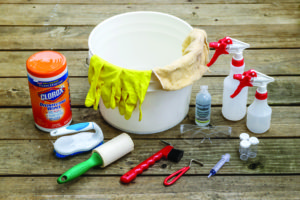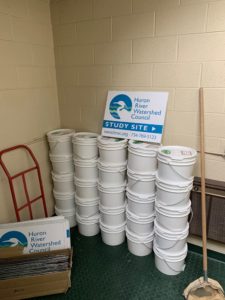June 11, 2019

Scientific monitoring is essential for learning more about our environment, but scientists and volunteers can transfer invasive species from one place to another and cause more harm than good!
Thanks to funding from EGLE and the U.S. Fish and Wildlife Service, the Huron River Watershed Council created and distributed 178 kits to 25 stream monitoring organizations across Michigan. Going forward, all MiCorps stream monitors will do the right thing and prevent the spread of invasive species!
It is easy to remember the process: inspect, remove, and disinfect and dry.

- Inspect. As easy as it sounds! Check out all your gear and clothes to make sure no plants or animals are being taken from the study site.
- Remove. Kits include brushes, picks, lint brushes, and towels so volunteers can physically remove unwanted plant and animal hitchhikers.
- Disinfect and Dry. Volunteer monitors often directly go from one water body to another, and it is in these situations where the danger of invasive species spread is the highest. The kits contain a dilute bleach solution and the volunteers are instructed to spray down nets, waders, and anything else that could be hiding invasive species, and then allow the equipment to sit for 10 minutes before washing the bleach off and towel drying.
To learn more, check out these resources:
- 3 minute video: https://www.hrwc.org/volunteer/decontaminate/
- Tip Book (pdf)





